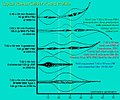Martin Fackler
Martin L. Fackler | |
|---|---|
 High speed photo of 10% ballistic gelatin showing terminal fragmentation of a .243 projectile | |
| Born | April 8, 1933 |
| Died | May 23, 2015 (aged 82) |
| Occupation(s) | retired Colonel United States Army, physician, surgeon and renowned specialist in wound ballistics |
| Spouse | Sandra Fox Fackler |
Martin L. Fackler (1933–2015) was an American military officer, surgeon and wound ballistics expert. He served in the U.S Navy from 1960 to 1975 and in the U.S. Army from 1975 to 1991. He was a field surgeon at the Naval Support Hospitals at Da Nang, Vietnam and at Yokosuka, Japan, and later a colonel in the US Army's Medical Corps.[1] He was the founder and head of the Wound Ballistics Laboratory for the Letterman Army Institute of Research from 1981 to 1991.[2][3] He was a member and leader of numerous distinguished organizations, among them the International Wound Ballistics Association, the French Wound Ballistics Society and the American Academy of Forensic Sciences.[4] Dr. Fackler had numerous teaching appointments and was the author of over 300 publications in regards to wound ballistics, body armor, and treatment of injuries for both the military and civilian populations.[5] He is credited with a number of contributions to the field of terminal ballistics, including:[6][7][8]
- Developing and testing improved media in which the effects of bullet wounds could be simulated. This led to the widespread acceptance of 10% ballistic gelatin for evaluating penetration and expansion of projectiles.
- Establishing effects of projectile design and shape on wounding.
- He hypothesized that wound depth was much more important than previously thought, and recommended ammunition that could send a bullet at least twelve inches into his ballistic gelatin.
- He was the first researcher to demonstrate that fragmentation was the most effective means of inflicting wounds in a modern military rifle round. He asserted that the "permanent wound cavity" or actual damage caused by a projectile is the primary "stopping power" mechanism and that the "temporary wound cavity" or shock wave produced by the projectile is at best a secondary mechanism, if not irrelevant.[9]
Gallery
[edit]Examples of Fackler's work on behalf of the U.S. military:
-
Wound ballistics for various Soviet cartridges
-
AK-47 7.62x39mm wound ballistics
-
AK-74 5.45x39mm wound ballistics
-
M16 M193 5.56x45mm wound ballistics
-
M16A2 M855 5.56X45mm NATO wound ballistics
References
[edit]- ^ Martin L. Fackler Collection (AFC/2001/001/85182), Veterans History Project, American Folklife Center, Library of Congress
- ^ "MARTIN L. FACKLER Jr. Obituary (2015) Gainesville Sun". Legacy.com.
- ^ http://memory.loc.gov/diglib/vhp-stories/loc.natlib.afc2001001.85182/sr0001001.stream?start=2936&clipid=d54525e120 Audio Interview with Martin Fackler.
- ^ "MARTIN L. FACKLER Jr. Obituary (2015) Gainesville Sun". Legacy.com.
- ^ "MARTIN L. FACKLER Jr. Obituary (2015) Gainesville Sun". Legacy.com.
- ^ "Terminal Ballistics". Rathcoombe.net. Retrieved 2014-08-06.
- ^ http://www.backwoodshome.com/articles2/ayoob93.html:"This resulted in the FBI Wound Ballistics Workshop of 1988 in Quantico, Virginia. Among those present were Dr. Martin Fackler, head of wound ballistics research for the US Army's medical training center, Letterman Institute. Fackler had developed an improved ballistic gelatin model that he had scientifically correlated to swine muscle tissue, which in turn is comparable to human muscle tissue. He hypothesized that wound depth was much more important than previously thought, and recommended ammunition that could send a bullet at least twelve inches into his ballistic gelatin."
- ^ http://www.firearmsid.com/Gelatin/Ballistic%20Gelatin%20Report.pdf [bare URL PDF]
- ^ Patrick, Urey (July 14, 1989). "Handgun Wounding Factors and Effectiveness" (PDF). Firearms Tactical. Federal Bureau of Investigation. Archived from the original (PDF) on November 24, 2005. Retrieved 2023-09-04.
NATO Handbook Emergency War Surgery Chapter entitled Missile Caused Wounds was authored by Fackler.
External links
[edit]- Shooting Holes in Wounding Theories: The Mechanics of Terminal Ballistics Archived 2021-06-24 at the Wayback Machine
- What's wrong with the wound ballistics literature, and why
- Firearms Tactical Institute's Wound Ballistic site, Internet Archive copy, includes articles by Fackler.
- THE EFFECTS OF SMALL ARMS ON THE HUMAN BODY, By Martin L. Fackler, MD
- The Library of Congress, Veterans History Project, Home Experiencing War: Stories from the Veterans History Project, Martin L. Fackler, October 26, 2011...Audio Interviews with Martin Fackler.




